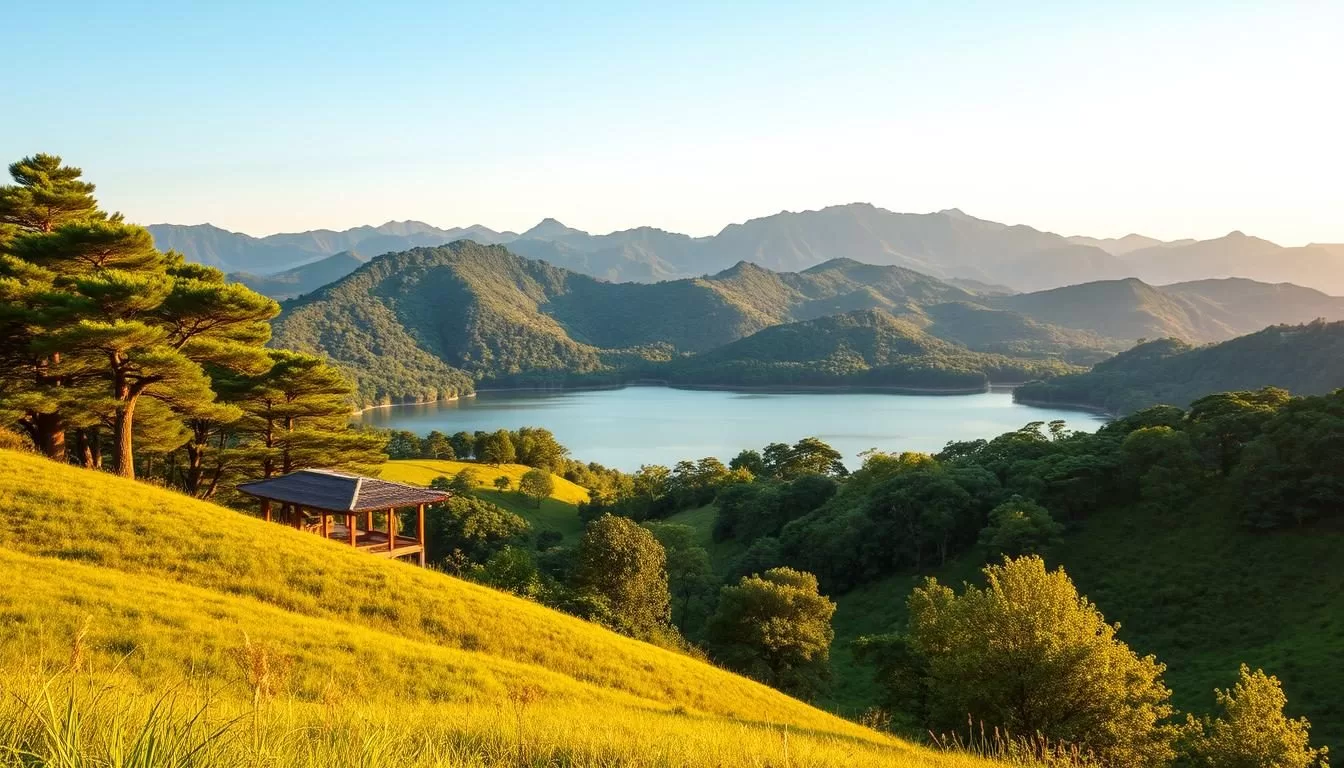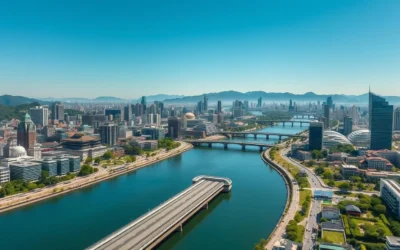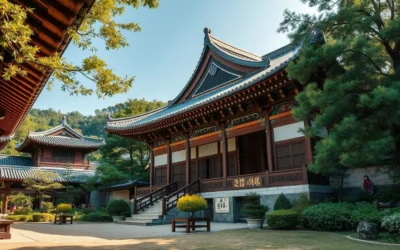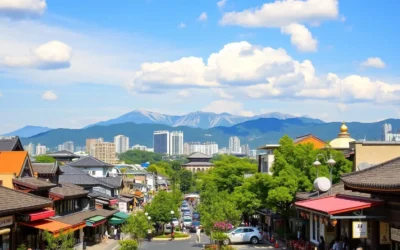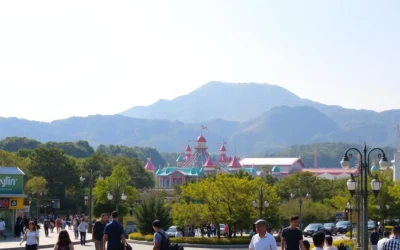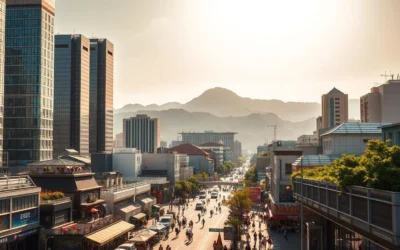✓ Accommodations✓ Flights✓ Rental Cars
Step into a city where history comes alive. Gyeongju, often called a “museum without walls,” offers a unique blend of ancient traditions and modern charm. This destination is perfect for your next trip if you love exploring cultural landmarks and scenic beauty.
Once the capital of the Silla dynasty, Gyeongju boasts a rich heritage that spans nearly a thousand years. From majestic temples to ancient tombs, every corner tells a story. The Gyeongju National area is home to some of the most well-preserved historical sites in the region.
Whether you’re strolling through the Daereungwon Tomb Complex or marveling at the Cheomseongdae Observatory, there’s something for everyone. Don’t forget to try local delicacies like Gyeongju bread, a treat that has been enjoyed since 1939.
Plan your visit to this enchanting city and immerse yourself in its timeless allure. Your trip to Gyeongju promises unforgettable adventures and lasting memories.
Exploring the Rich History of Gyeongju
Uncover the layers of history in a city that once ruled an ancient kingdom. The Silla Dynasty, which thrived from 57 BC to 935 AD, left behind a legacy that continues to captivate visitors today. This era’s influence is evident in the intricate stone constructions and the sprawling tomb complexes that dot the landscape.
Discovering the Silla Dynasty Legacy
The Silla Dynasty was one of Korea’s most powerful kingdoms, and its capital was a hub of culture and innovation. UNESCO recognized the historical significance of this era by designating its sites as a World Heritage Site in 2000. The kingdom’s achievements in art, architecture, and governance are still celebrated today.
Ancient Tomb Complexes and Tumuli
The tomb complexes in this region are a testament to the grandeur of the Silla Dynasty. The Daereungwon area features 23 burial mounds, including the Hwangnam Daechong Tomb, which measures 80 by 120 meters and houses over 30,000 relics. These mounds, made of earth and stone, are more impressive in person than in photographs.
| Site | Highlights |
|---|---|
| Daereungwon Tomb Complex | 23 burial mounds, Hwangnam Daechong Tomb |
| Cheonmachong Tomb | Over 12,000 artifacts, including a gold crown |
| Geumgwanchong Tomb | Largest gold crown ever recovered |
Exploring these sites offers a tangible connection to Korea’s past. The artifacts and stone structures provide a glimpse into the artistic and cultural achievements of the Silla Dynasty. Whether you’re a history enthusiast or a casual traveler, these landmarks are a must-see.
Uncovering the Hidden Heritage Sites
Discover the quiet charm of heritage sites often overlooked by travelers. Beyond the well-trodden paths, you’ll find historical gems that offer a serene and immersive experience. These sites are steeped in culture and history, waiting to be explored.
One such hidden treasure is the site of the ancient Silla dynasty’s lesser-known temples. These structures, though smaller in scale, are rich in artistic detail and historical significance. They provide a peaceful retreat from the bustling tourist spots.
Your guide to these locations starts with the quiet beauty of the Namsan Mountain area. Here, you’ll find stone carvings and pagodas that tell stories of a bygone era. The tranquility of this heritage site makes it a perfect spot for reflection and discovery.
Another must-visit is the Gyerim Forest, a mystical site surrounded by legends. This forest is said to be the birthplace of a Silla king, and its lush greenery adds to its enchanting atmosphere. Walking through it feels like stepping back in time.
To make the most of your visit, plan your trip early in the day. This allows you to enjoy the sites in their full glory, free from crowds. Wear comfortable shoes, as some locations require a bit of walking. Don’t forget to bring a camera to capture the hidden beauty of these cultural treasures.
Exploring these lesser-known heritage sites offers a unique perspective on the region’s history. They are a testament to the enduring legacy of the Silla dynasty and a reminder of the quiet charm that lies off the beaten path.
Top Landmarks You Must Experience
Step into a world where ancient wonders meet modern marvels. This section highlights two iconic landmarks that showcase the rich history and innovative architecture of the region. From the oldest observatory in Asia to a sprawling tomb complex, these sites are essential stops on your journey.
Cheomseongdae Observatory Highlights
Built in the 7th century, the Cheomseongdae observatory is a testament to ancient astronomical ingenuity. It’s the oldest of its kind in Asia, constructed with 365 stones representing the days of the year and 12 stones for the months. This structure, measuring 5.17 meters in diameter and 9 meters tall, was used to study the stars and predict seasonal changes.
Visitors can marvel at its precise design and learn about its role in shaping early scientific thought. The observatory is a symbol of the region’s historical advancements and a must-see for history enthusiasts.
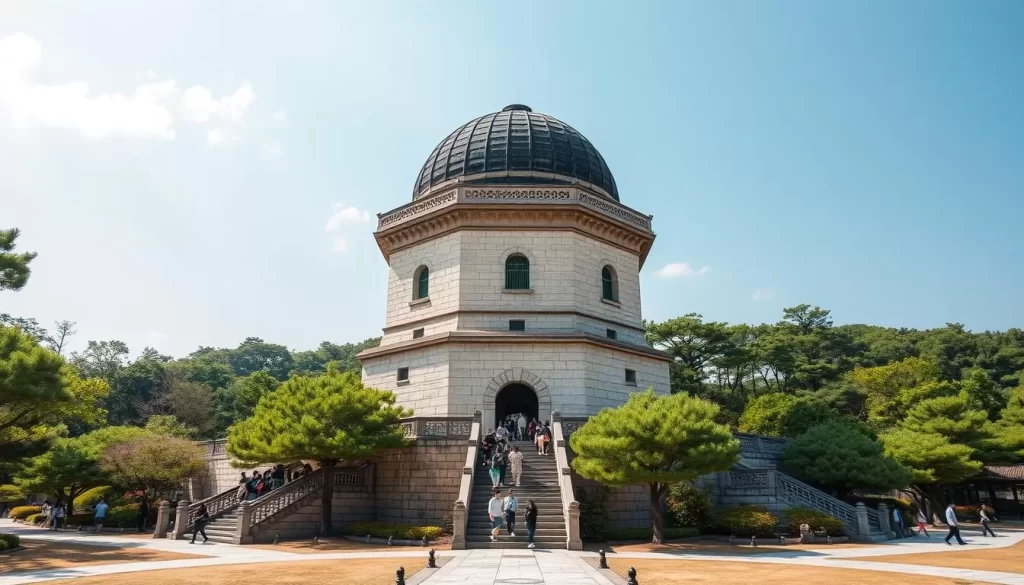
Daereungwon Tomb Complex Insights
The Daereungwon tomb complex offers a fascinating glimpse into the burial traditions of the Silla period. This site features 23 burial mounds, including the impressive Hwangnam Daechong Tomb, which spans 80 by 120 meters. Each mound is a treasure trove of artifacts, revealing the artistic and cultural achievements of the era.
Walking through this tomb complex feels like stepping back in time. The serene atmosphere and historical significance make it a memorable experience for all visitors.
| Landmark | Key Features |
|---|---|
| Cheomseongdae Observatory | Oldest observatory in Asia, 365 stones, 12 stones for months |
| Daereungwon Tomb Complex | 23 burial mounds, Hwangnam Daechong Tomb |
These landmarks are not just historical sites but also symbols of the region’s enduring legacy. Whether you’re exploring the ancient observatory or wandering through the tomb complex, you’ll gain a deeper appreciation for the rich heritage of this area.
Discovering Donggung Palace and Wolji Pond
Step into the enchanting world of Donggung Palace and Wolji Pond, where history and nature blend seamlessly. This area transforms into a magical realm at night, offering a unique experience that combines ancient architecture with serene natural beauty.
Evening Magic: Lighted Palatial Views
As the sun sets, Donggung Palace and Wolji Pond come alive with lights. The illuminated palace reflects on the calm waters of the pond, creating a breathtaking scene. This nighttime view is a must-see for anyone visiting the area.
The palace, once a secondary royal residence, has been meticulously reconstructed to preserve its historical integrity. The adjacent pond, originally built for royal banquets, adds to the charm with its tranquil waters and surrounding greenery.
Visitors can explore the area and learn about its significance in the region’s history. The interplay of natural landscapes and man-made heritage creates a storied atmosphere that is both educational and visually stunning.
For the best experience, plan your visit in the evening when the lights are on. The entrance fee is 3,000 KRW (approximately $2), making it an affordable yet unforgettable experience.
Whether you’re a history enthusiast or simply looking for a romantic evening, Donggung Palace and Wolji Pond offer a magical escape into the past. Don’t forget to bring your camera to capture the beauty of this illuminated wonder.
Gyeongju National Park, South Korea: Best Things to Do – Top Picks
Make the most of your day exploring a city rich in history and culture. From ancient landmarks to serene landscapes, there’s something for everyone. Whether you’re a history buff or a nature lover, this destination offers unforgettable experiences.
Public transportation makes it easy to navigate the area. The bus system is efficient and affordable, connecting major attractions seamlessly. For a faster option, the train from nearby cities like Seoul or Busan takes just a few hours.
Start your day early to maximize your time. Visit iconic sites like the Daereungwon Tomb Complex or the Cheomseongdae Observatory. These landmarks offer a glimpse into the region’s rich heritage and are easily accessible by bus.
Planning your itinerary is simple with the available transportation options. The train and bus schedules are designed to help you explore efficiently. Don’t forget to check timings to make the most of your visit.
With so much to see and do, this destination is perfect for a day trip or a longer stay. Use public transport to your advantage and enjoy a hassle-free adventure. Your journey promises to be both convenient and memorable.
Scenic Walks in Gyochon Hanok Village
Take a leisurely stroll through a place where history meets charm. Gyochon Hanok Village is a location that offers a perfect blend of traditional Korean architecture and modern comfort. Here, you’ll find over 160 old houses, some dating back 500 years, preserved to showcase their timeless beauty.
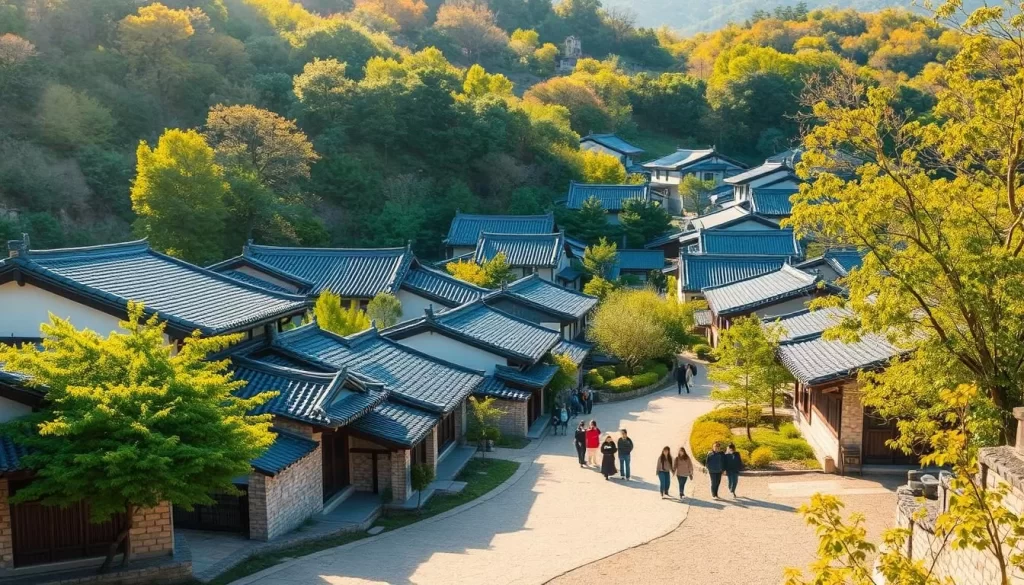
This village is a haven for those who appreciate cultural heritage. Its narrow streets and hanok houses create a nostalgic atmosphere that feels like stepping back in time. The warm hospitality of local shop owners adds to the charm, making it a must-visit location.
Traditional Hanok Architecture
The hanok houses in this village are a testament to Korean craftsmanship. With their curved roofs and wooden beams, these structures are both functional and beautiful. Fifty-four of these homes are over 200 years old, offering a rare glimpse into the past.
As you walk through the village, you’ll notice the intricate details of each hanok. From the stone foundations to the paper windows, every element tells a story. This location is a living museum, where history comes alive in every corner.
Cozy Cafés and Local Shops
After exploring the architecture, take a break at one of the cozy cafés. These spots offer a chance to relax and enjoy traditional Korean treats. The local shops are also worth a visit, with unique souvenirs and handmade goods.
Getting around the village is easy on foot. The compact layout makes it simple to explore every nook and cranny. Whether you’re sipping tea in a café or browsing through shops, this location invites you to slow down and savor the moment.
| Feature | Details |
|---|---|
| Hanok Houses | Over 160 old houses, some 500 years old |
| Local Shops | Unique souvenirs and handmade goods |
| Accessibility | Easy to get around on foot |
Gyochon Hanok Village is more than just a location; it’s an experience. Its blend of history and modern comfort makes it a perfect spot for a scenic walk. Take your time to explore and enjoy the charm of this timeless village.
Must-Visit Buddhist Heritage Sites
Immerse yourself in the spiritual heart of a region known for its ancient Buddhist heritage. Here, you’ll find two of the most revered sites that have stood the test of time. These locations are not just historical landmarks but also places of deep spiritual significance.
Bulguksa Temple: A UNESCO Treasure
Bulguksa Temple is a masterpiece of Buddhist art and architecture. Built during the Silla Dynasty in 528, it serves as the head temple of the Jogye Order of Korean Buddhism. Its intricate design includes a staircase with 33 steps, symbolizing the 33 heavens of Buddhism.
Designated as a UNESCO World Heritage site, this temple is a cultural treasure. Its preservation efforts ensure that visitors can experience its beauty as it was centuries ago. The temple’s serene atmosphere makes it a perfect spot for reflection and discovery.
Seokguram Grotto: Spiritual Reflections
Just a short distance from Bulguksa Temple, you’ll find the Seokguram Grotto. This site houses an exquisite Buddha statue, carved with remarkable precision. The grotto’s design allows natural light to illuminate the statue, creating a spiritual ambiance.
Like the temple, the grotto is part of the UNESCO World Heritage list. Its preservation is a testament to the dedication of those who protect these ancient sites. Visiting this grotto offers a unique opportunity to connect with the region’s spiritual past.
Both Bulguksa Temple and Seokguram Grotto continue to inspire pilgrims and tourists alike. Their timeless beauty and historical significance make them must-visit destinations for anyone exploring this region.
Planning Your Visit: Getting Around Gyeongju
Exploring a city rich in history is easier when you know how to get around. Public transportation is your best friend here, offering convenience and affordability. Whether you prefer buses or taxis, navigating the area is straightforward and stress-free.
Public Transport and Taxi Options
The bus terminal is a central hub connecting you to major attractions. Buses are frequent, and routes are well-marked, making it easy to take bus to your desired stop. Most buses run from early morning until late evening, ensuring you can explore at your own pace.
Here are some tips for using public transport:
- Check the schedule at the bus terminal to plan your day efficiently.
- Use a transportation app to track routes and timings in real-time.
- Major stops are located near popular sites, so plan your itinerary accordingly.
If you prefer a more private option, taxis are readily available. They’re affordable, with rides between attractions costing around 7,000–15,000W ($5.50–$11). Taxis are a great choice if you’re short on time or traveling with a group.
Walking is another excellent way to explore, especially in areas with dense attractions. The city’s layout is compact, and many sites are within walking distance of each other. Wear comfortable shoes and enjoy the scenic routes between destinations.
With these options, getting around is simple and efficient. Whether you take bus, hail a taxi, or stroll on foot, you’ll find it easy to navigate and enjoy your visit.
Practical Itinerary Planning for Your Trip
Crafting the perfect itinerary ensures you make the most of your trip without feeling rushed. Start by listing the attractions you want to visit and estimate the time needed for each. This helps you create a balanced schedule that fits your interests and available time.
When planning, consider the minutes it takes to travel between locations. For example, the bus journey from Busan takes about 1 hour, while the train from Seoul takes just over 2 hours. Allocate extra time for unexpected delays to keep your day stress-free.
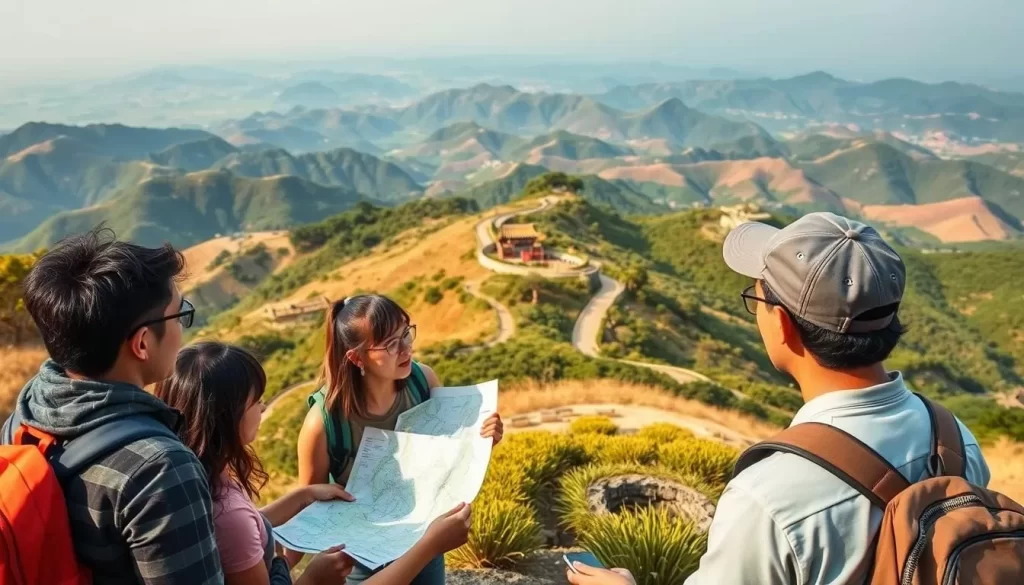
Budgeting is another key aspect. Entry fees for popular sites like the Daereungwon Tomb Complex or Bulguksa Temple range from 3,000 to 5,000 KRW. Factor in transportation costs, such as bus or taxi fares, to get a clear idea of your total price.
Here’s a quick guide to help you plan:
- Allocate 1-2 hours for major attractions like the Cheomseongdae Observatory.
- Set aside 30 minutes for smaller sites or quick stops.
- Include buffer time for meals and rest breaks.
For a seamless experience, use a transportation app to track bus and train schedules. This ensures you don’t waste time waiting and can move efficiently between stops. If you’re visiting multiple cities, consider a 10-day itinerary to explore more without rushing.
By planning ahead, you can enjoy a well-organized trip that maximizes your time and minimizes stress. Whether you’re exploring ancient sites or modern attractions, a thoughtful itinerary ensures a memorable experience.
Day and Night Adventures in Gyeongju
Experience the duality of a city that shines in daylight and glows under the stars. From ancient landmarks to illuminated wonders, this destination offers two distinct yet equally captivating experiences. Whether you’re exploring in the sun or marveling at the evening lights, each hour brings something new to discover.
Daytime Explorations
During the day, the city reveals its rich history and cultural treasures. Wander through ancient sites like the Daereungwon Tomb Complex, where 23 burial mounds tell stories of a bygone era. The relaxed pace allows you to soak in the details of each landmark, from intricate carvings to serene landscapes.
For a deeper dive into the past, visit Bulguksa Temple, a UNESCO World Heritage site that spans over 100 acres. Its stunning architecture and peaceful surroundings make it a perfect spot for reflection. Daytime explorations are ideal for those who enjoy a slower, more immersive experience.
Nighttime Illuminations
As the sun sets, the city transforms into a magical wonderland. Landmarks like Donggung Palace and Wolji Pond come alive with lights, creating a breathtaking scene. The illuminated reflections on the water add a dramatic touch, making it a must-see for evening visitors.
Special events and festivals often take place at night, adding to the vibrant atmosphere. The annual culture festival at Gyeongju World Culture Expo Park, held in October, features performances and activities that highlight the region’s heritage. Nighttime adventures offer a unique perspective, blending history with modern charm.
“The city’s nighttime beauty is unmatched, offering a visual feast that stays with you long after you leave.”
To make the most of your visit, plan your day to include both daytime and nighttime activities. Start early to explore historical sites and end your hours with a stroll through illuminated landmarks. This balance ensures you experience the best of both worlds.
For more tips on how to explore Gyeongju’s heritage, check out our detailed guide. Whether you’re here for a day or a year, the city’s dual charm promises unforgettable memories.
Local Culture, Cuisine, and Gyeongju Bread
Dive into the vibrant local culture and savor the flavors of a city known for its culinary heritage. From bustling markets to cozy bakeries, this area offers a lot to explore. Whether you’re a foodie or a culture enthusiast, you’ll find something to love in every corner.
One of the highlights of this place is the traditional Gyeongju bread. This sweet pastry, filled with red bean paste, has been a local favorite since 1939. You’ll find it in bakeries throughout the city, each with its own unique twist on the classic recipe.
For a deeper dive into the local food scene, visit the bustling markets. These lively places are filled with stalls offering everything from fresh produce to street food. Gwangjang Market, for example, features over 200 food stalls catering to both traders and food tourists. It’s a great spot to try authentic Korean dishes and interact with locals.
The blend of traditional and modern settings is another defining feature of this area. In one place, you might find a centuries-old hanok house next to a trendy café. This mix of old and new creates a unique atmosphere that’s both nostalgic and forward-thinking.
Here are some practical tips to help you navigate the local food scene:
| Spot | Highlights |
|---|---|
| Local Bakeries | Traditional Gyeongju bread, unique pastries |
| Gwangjang Market | Over 200 food stalls, authentic Korean dishes |
| Hanok Cafés | Blend of traditional and modern settings |
To make the most of your visit, start early and explore at your own pace. Wear comfortable shoes, as some places require a bit of walking. Don’t forget to bring cash, as smaller stalls may not accept cards.
For more insights into the rich culture and history of this area, check out this detailed guide. Whether you’re here for the food or the culture, this place promises a lot of unforgettable experiences.
Immersive Museum and Expo Park Experiences
Step into a world where history and culture come alive through immersive exhibits and interactive displays. The national museum and Expo Park offer a unique blend of ancient artifacts and modern storytelling, making them must-visit destinations for anyone exploring the area.
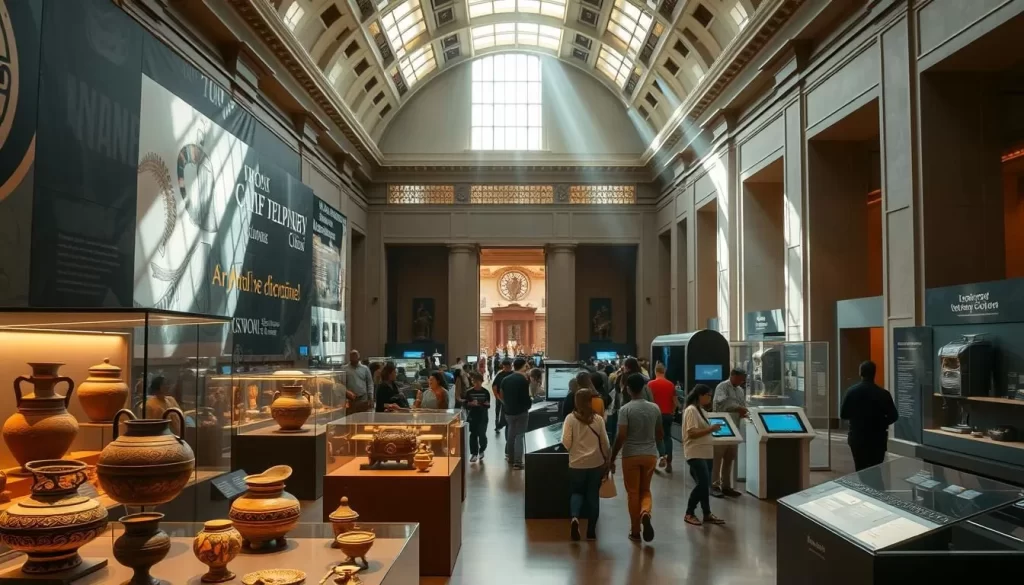
Highlights of the Gyeongju National Museum
The national museum is a treasure trove of historical collections. With over 12,000 artifacts, it provides a comprehensive look into the region’s rich heritage. The exhibits are thoughtfully curated to tell the story of the city’s cultural evolution, offering more than just artifacts—they provide context and depth.
One of the standout features is the Immersive Digital Gallery, which requires an online reservation. This gallery uses cutting-edge technology to bring history to life, making it a favorite among visitors. The museum also offers guided tours in English, Chinese, and Japanese, ensuring everyone can fully appreciate the exhibits.
Interactive Displays at the Expo Park
Just a short distance from the museum, the Expo Park offers a different kind of experience. Here, interactive displays and immersive installations make history engaging and accessible. The park is designed to complement the national museum, providing a broader narrative of the region’s heritage.
Visitors can explore themed exhibitions that change seasonally, ensuring there’s always something new to discover. The park’s layout encourages exploration, with walking trails that connect various exhibits and installations.
Practical Tips for Your Visit
To make the most of your time, plan your visit to the museum and Expo Park early in the day. The museum is open from 10:00 AM to 6:00 PM on weekdays and until 9:00 PM on Wednesdays and Saturdays. Admission is free, except for special exhibitions, making it an affordable option for families and solo travelers alike.
Here’s a quick guide to help you plan your visit:
| Location | Highlights | Tips |
|---|---|---|
| National Museum | 12,000 artifacts, Immersive Digital Gallery | Book online for special exhibits |
| Expo Park | Interactive displays, seasonal exhibitions | Wear comfortable shoes for walking |
For more information on the Gyeongju World Culture Expo Park, check out the official guide. Whether you’re a history buff or just looking for a fun day out, these attractions offer something for everyone.
Seasonal Splendors: Cherry Blossoms and More
Witness the breathtaking transformation of historical landmarks as cherry blossoms paint the landscape in delicate hues. These seasonal displays add a unique charm to the region, especially near its world heritage sites.
From late March to early April, the cherry blossoms bloom, creating a stunning contrast against ancient architecture. This natural spectacle draws visitors from around the globe, eager to experience the beauty of spring.
The world heritage status of these sites ensures their preservation, allowing future generations to enjoy their historical and natural grandeur. The interplay between seasonal beauty and cultural heritage is truly mesmerizing.
For the best experience, plan your visit during the peak blooming period. Early mornings or late afternoons offer the perfect lighting for photography, capturing the soft hues of the cherry blossoms.
Here’s a quick guide to help you plan your trip:
| Event | Dates | Highlights |
|---|---|---|
| Jinhae Cherry Blossom Festival | April 1 – April 10 | Millions of visitors, starlight festival |
| Gyeongju Cherry Blossom Festival | March 31 – April 9 | Historical landmarks, cultural events |
| Yeouido Spring Flower Festival | April 7 – April 12 | 1,886 cherry trees, Han River views |
For more tips on exploring seasonal beauty, check out this Sokcho travel guide. Whether you’re here for the cherry blossoms or the world heritage sites, this region promises unforgettable memories.
Insider Tips for a Relaxing Getaway
Planning a trip to a historic destination can be both exciting and overwhelming, but with the right tips, you can ensure a relaxing and enriching experience. Whether you’re an adult traveler seeking culture or simply looking to unwind, these insights will help you make the most of your visit.
Spring (April to June) and autumn (September to November) are the best times to explore. Mild temperatures and vibrant colors create a serene atmosphere, perfect for leisurely strolls. Visiting a temple in the early morning or late afternoon ensures fewer crowds and a peaceful experience.
For a truly unique experience, incorporate the palace Wolji area into your itinerary. The illuminated views at night are breathtaking, and the tranquil pond adds to the charm. This spot is ideal for those looking to blend history with relaxation.
Here are some practical tips for your trip:
- Allocate 2-3 days to explore at a relaxed pace.
- Use public transport for convenience and affordability.
- Wear comfortable shoes for walking through historic sites.
For more detailed insights, check out this guide to South Korea for the first-time. With these tips, your getaway will be both enriching and stress-free.
Essential Travel Tips for International Visitors
Navigating a new city can be seamless with the right tips and tricks. For international visitors, understanding the local transportation system is key to a stress-free experience. Public transport, including buses and trains, is efficient and affordable, connecting major attractions with ease.
One of the must-visit landmarks is the woljeonggyo bridge, a picturesque spot that offers stunning views and a glimpse into the area’s history. Use this landmark as a reference point to orient yourself while exploring. The bridge is easily accessible by bus, with nearby stops clearly marked.
When moving around, be mindful of walls or barriers that may affect your route. These are often found near historical sites and can sometimes limit direct access. Plan your path in advance to avoid detours and save time.
Here are some quick tips to enhance your visit:
- Use a T-money card for public transport—it’s convenient and cost-effective.
- Check bus schedules at the terminal to plan your day efficiently.
- Wear comfortable shoes, as some areas require walking.
For a smooth journey, consider these practical insights:
| Tip | Details |
|---|---|
| Transportation | Use T-money card, check bus schedules |
| Landmarks | Visit woljeonggyo bridge, use as reference point |
| Navigation | Be aware of walls or barriers near historical sites |
With these tips, you’ll feel confident and prepared to explore the city. Whether you’re crossing the woljeonggyo bridge or navigating around walls, your trip will be both enjoyable and hassle-free.
Conclusion
Wrap up your journey with a visit to a destination that seamlessly blends history and modern convenience. From ancient palaces to well-connected stations, this place offers an unforgettable experience for every traveler.
Explore the grandeur of historical sites like the Donggung Palace, where illuminated views create a magical atmosphere. The nearby station ensures easy access to other attractions, making it simple to navigate the area.
Whether you’re marveling at the intricate designs of a palace or hopping on a train from the central station, every moment here is filled with discovery. Plan your trip to fully embrace the adventure that awaits.
For more tips on how to explore Gyeongju’s heritage, check out our detailed guide. Your journey promises to be both enriching and memorable.
The above is subject to change.
Check back often to TRAVEL.COM for the latest travel tips and deals.
